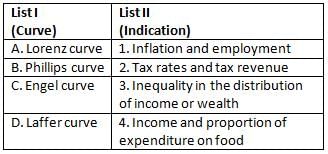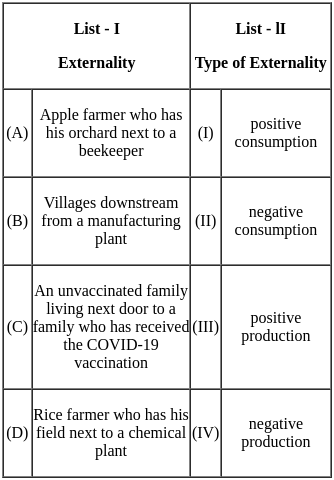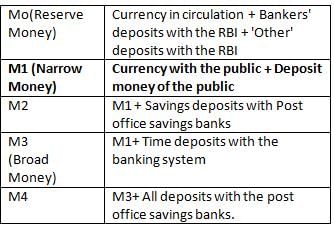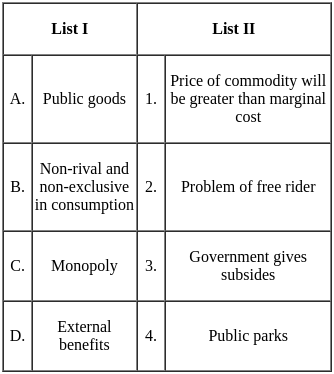CUET PG Economics Mock Test - 1 - CUET PG MCQ
30 Questions MCQ Test - CUET PG Economics Mock Test - 1
A utiltiy maximizing consumer has a utility function given by U(X, Y) = 2X + Y. He has a budget constrant given by X + 2Y = 10. In equilibrium he purchases
For inferior goods, the subsitution effect of a price decrease and the income effect of the same price decrease
Consider the following statements about public goods:
Statement I: Public goods are non-rivalrous.
Statement II: Public goods are non-excludable.
Statement III: Roads are a classic example of a pure public good.
Which of the above statements are correct?
Statement I: Public goods are non-rivalrous.
Statement II: Public goods are non-excludable.
Statement III: Roads are a classic example of a pure public good.
With respect to the four measures of money supply in India, viz., M1, M2, M3 and M4, which is the most liquid measure of money supply?
Which of the following is NOT considered a driver of economic globalization?
The arithmetic mean of two numbers exceeds their geometric mean by 2 and the geometric mean exceeds their harmonic mean by 1.6. What are the two numbers?
Consider the following statements:
1. A continuous random variable can take all values in an interval.
2. A random variable which takes a finite number of values is necessarily discrete.
3. Construction of a frequency distribution is based on data which are discrete.
Which of the above statements are correct?
Which of the following is a correct measure of Fiscal Deficit ?
A. Fiscal deficit = Total expenditure - Total receipts (excluding borrowings).
B. Fiscal deficit = (Revenue expenditure + Capital expenditure) - (Revenue receipts + Capital receipts excluding borrowings).
C. Fiscal deficit = (Revenue expenditure - Revenue receipts) -(Capital expenditure - Capital receipts excluding borrowings).
What is the difference between probability sampling and non-probability sampling?
Identify the correct statements regarding the money supply
(A) Money supply is a stock concept.
(B) Money supply is a flow concept.
(C) Money supply is the currency (cash and coins) with the public and demand deposit in banks.
(D) Money supply is the currency held with banks.
(E) Money supply is the concept of real flow.
Choose the correct answer from the options given below:
Match List I with List II and select the correct answer using the code given below the lists :

Let biased coin be tossed 5 times. If the probability of getting 4 heads is equal to the probability of getting 5 heads, then the probability of getting at most two heads is:
The Keynesian theory of money demand predicts that people will increase their money holdings if they believe that
Arrange the following events on a chronological order
(A) New Economic Policy - Liberalisation
(B) Drain of Wealth
(C) White Revolution
(D) Monopolies Inquiry Commission
Choose the correct answer from the options given below:
Which two of the following are the function of WTO
(a) To facilitate the implementation, administration and operation of trade agreement
(b) To carry out periodic reviews of the trade policies of its member countries
(c) To assist in the establishment of a multilateral system of payments
(d) To promote international monetary cooperation
Choose the correct option from the following:
Among all the unbiased Estimators Of the population regression coefficients which are linear in the dependent variable (say Yi), the least squares estimators have the smallest variance.
This statement is known as:
Match List-I with List-ll

Choose the correct answer from the options given below:
The probability that a contractor gets a plumbing contract is 2/3 and the probability that he will not get an electric contract is 5/9. If the probability of getting at least one contract is 4/5, then the probability that he will get both the contracts is:







 and A.M. =
and A.M. = 
 = 8 and
= 8 and  = 10
= 10











